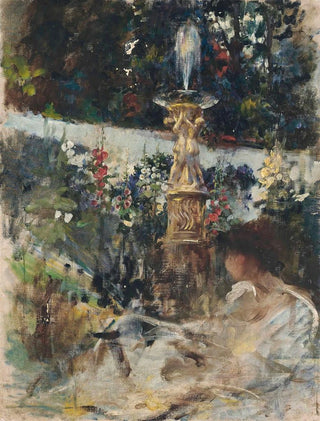Art print | Reading by the fountain edge - James Jebusa Shannon


View from behind

Frame (optional)
In the vibrant universe of art, some works manage to capture the very essence of life and beauty. "Lecture au bord de la fontaine" by James Jebusa Shannon is a shining example. This piece, imbued with serenity and delicacy, transports us to a suspended moment where time seems to stand still. The scene depicts a young woman absorbed in her reading, sitting in the shade of a tree, while a fountain gently murmurs beside her. This composition evokes not only a moment of peace but also an invitation to contemplation. The soft light bathing the scene creates an intimate atmosphere, conducive to escape and daydreaming.
Style and uniqueness of the work
Shannon's style is distinguished by meticulous attention to detail and subtle use of color. In "Lecture au bord de la fontaine," delicate shades of green and blue blend harmoniously, evoking the freshness of a summer afternoon. The textures of the protagonist's clothing and natural elements are rendered with precision that reflects the artist's craftsmanship. The posture of the young woman, both relaxed and focused, conveys a certain grace and psychological depth. The work is also characterized by a play of shadows and lights, which accentuates the relief of the forms and creates an almost tangible atmosphere. In sum, every element of this painting contributes to its singularity, making it a true masterpiece of the late 19th century.
The artist and his influence
James Jebusa Shannon, Anglo-American painter, is recognized for his ability to capture the beauty of everyday life through his works. Born in 1862, he established himself in the art world thanks to his innovative approach and keen sense of aesthetics. Influenced by the Impressionist movement, Shannon developed a personal style that combines realism and poetry. His paintings, often populated with female figures, explore themes such as solitude, contemplation, and the beauty of nature. "Lecture au bord de la fontaine" fits perfectly within this tradition, while revealing his originality.

Matte finish

View from behind

Frame (optional)
In the vibrant universe of art, some works manage to capture the very essence of life and beauty. "Lecture au bord de la fontaine" by James Jebusa Shannon is a shining example. This piece, imbued with serenity and delicacy, transports us to a suspended moment where time seems to stand still. The scene depicts a young woman absorbed in her reading, sitting in the shade of a tree, while a fountain gently murmurs beside her. This composition evokes not only a moment of peace but also an invitation to contemplation. The soft light bathing the scene creates an intimate atmosphere, conducive to escape and daydreaming.
Style and uniqueness of the work
Shannon's style is distinguished by meticulous attention to detail and subtle use of color. In "Lecture au bord de la fontaine," delicate shades of green and blue blend harmoniously, evoking the freshness of a summer afternoon. The textures of the protagonist's clothing and natural elements are rendered with precision that reflects the artist's craftsmanship. The posture of the young woman, both relaxed and focused, conveys a certain grace and psychological depth. The work is also characterized by a play of shadows and lights, which accentuates the relief of the forms and creates an almost tangible atmosphere. In sum, every element of this painting contributes to its singularity, making it a true masterpiece of the late 19th century.
The artist and his influence
James Jebusa Shannon, Anglo-American painter, is recognized for his ability to capture the beauty of everyday life through his works. Born in 1862, he established himself in the art world thanks to his innovative approach and keen sense of aesthetics. Influenced by the Impressionist movement, Shannon developed a personal style that combines realism and poetry. His paintings, often populated with female figures, explore themes such as solitude, contemplation, and the beauty of nature. "Lecture au bord de la fontaine" fits perfectly within this tradition, while revealing his originality.






